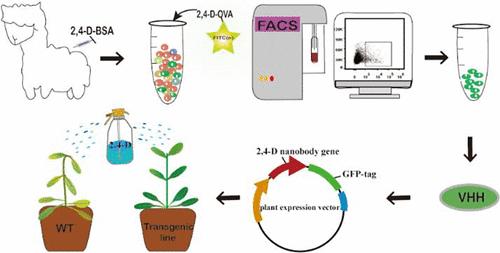2,4-二氯苯氧乙酸纳米体基因的高效筛选及其在植物中的表达
IF 6.2
1区 农林科学
Q1 AGRICULTURE, MULTIDISCIPLINARY
引用次数: 0
摘要
生物技术过程中的免疫调节需要在受影响细胞中表达足够水平的特异性、高亲和力的重组抗体。在这里,我们报告了一种新的策略来获得对2,4-二氯苯氧乙酸(2,4- d)除草剂敏感的纳米体。与以往使用外周血淋巴细胞的方法不同,采用荧光素异硫氰酸酯标记的2,4- d包被抗原染色的特异性外周血淋巴细胞通过荧光活化细胞分选分离,并用于噬菌体展示文库的构建。该策略显著降低了抗载体蛋白纳米体噬菌体对小分子纳米体发育的干扰,并且只需要两个周期的筛选就能获得所需的阳性克隆。Nb4-11是最敏感的噬菌体克隆之一,对2,4- d具有良好的敏感性和特异性。与先前报道的2,4- d纳米体相比,Nb4-11的序列具有完全不同的互补决定区(cdr)。基于nb4 - 11的ic-ELISA的半最大抑制浓度为29.3±1.9 ng/mL。随后将Nb4-11基因转移到拟南芥中,使其具有抗除草剂能力,获得了纯合子转基因T3品系。通过PCR、ic-ELISA和Western blot分析,证实了2,4- d纳米体在模式植物中的稳定表达。在剂量-反应生物试验中,转基因T3株系对2 g 2,4- d /ha具有抗性。本研究提供了一种新的方法来筛选特异性外周淋巴细胞,有效地开发针对小分子的纳米体,并基于纳米体在植物中的表达建立了一种新的抗除草剂机制。本文章由计算机程序翻译,如有差异,请以英文原文为准。

Efficient Selection of the 2,4-Dichlorophenoxyacetic Acid Nanobody Gene from the Phage Library Constructed with Sorted Specific Cells and Expression in Plants to Confer Herbicide Resistance
Immunomodulation in biotechnological processes requires an adequate level of specific, high-affinity recombinant antibodies expressed in the affected cells. Here, we report a new strategy to obtain a sensitive nanobody against the 2,4-dichlorophenoxyacetic acid (2,4-D) herbicide. Unlike the previous methods that used total peripheral blood lymphocytes, specific peripheral lymphocytes stained with a fluorescein isothiocyanate-labeled 2,4-D coating antigen were isolated via fluorescence-activated cell sorting and used for phage display library construction. This strategy significantly reduced interference of anticarrier protein nanobody phages to small-molecule nanobody development and required only two cycles of panning to obtain the desired positive clones. Nb4–11, one of the most sensitive phage clones, showed good sensitivity and specificity against 2,4-D. Compared with previously reported 2,4-D nanobodies, the sequence of Nb4–11 exhibited completely different complementarity-determining regions (CDRs). The half-maximum inhibition concentration of the Nb4–11-based ic-ELISA was 29.3 ± 1.9 ng/mL. The Nb4–11 gene was subsequently transferred into Arabidopsis thaliana to confer herbicide resistance, and homozygous transgenic T3 lines were obtained. Stable expression of the 2,4-D nanobody in the model plant was confirmed via PCR, ic-ELISA, and Western blot analysis. In the dose-response bioassay, the transgenic T3 lines were resistant to 2 g of 2,4-D ai/ha. This work offers a new way to sort specific peripheral lymphocytes, efficiently develop nanobodies against small molecules, and create a novel mechanism for herbicide resistance based on the expression of nanobodies in plants.
求助全文
通过发布文献求助,成功后即可免费获取论文全文。
去求助
来源期刊
CiteScore
9.90
自引率
8.20%
发文量
1375
审稿时长
2.3 months
期刊介绍:
The Journal of Agricultural and Food Chemistry publishes high-quality, cutting edge original research representing complete studies and research advances dealing with the chemistry and biochemistry of agriculture and food. The Journal also encourages papers with chemistry and/or biochemistry as a major component combined with biological/sensory/nutritional/toxicological evaluation related to agriculture and/or food.

 求助内容:
求助内容: 应助结果提醒方式:
应助结果提醒方式:


